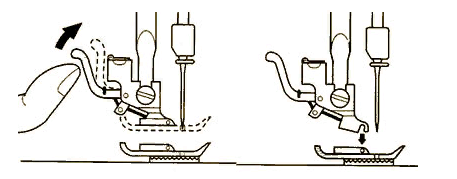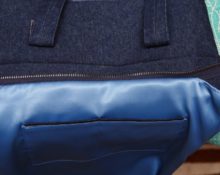 A properly sewn zipper is invisible in the seam of the product. It can be sewn into the back, middle or side seams, the main thing is that the fastener does not deform the product. You will need some skill in your work. The whole process consists of 3 stages: preparation, basting and stitching. For a beginner, it is recommended to try sewing a dress with a zipper on mock-up fabric (calico) or use a small piece of material. This way you will learn all the intricacies of the work.
A properly sewn zipper is invisible in the seam of the product. It can be sewn into the back, middle or side seams, the main thing is that the fastener does not deform the product. You will need some skill in your work. The whole process consists of 3 stages: preparation, basting and stitching. For a beginner, it is recommended to try sewing a dress with a zipper on mock-up fabric (calico) or use a small piece of material. This way you will learn all the intricacies of the work.
Materials and tools
 For the zipper, nylon spirals are used, which are designed for light load. When sewing a lock, it is important to stitch without touching the teeth. You need to attach the zipper not to the end of the part, but to the end of the lock. Before working with the fastener, you need to process the edges of the fabric with an overlocker or a sewing machine that imitates an overlock stitch. This way the edges of the product will not unravel.
For the zipper, nylon spirals are used, which are designed for light load. When sewing a lock, it is important to stitch without touching the teeth. You need to attach the zipper not to the end of the part, but to the end of the lock. Before working with the fastener, you need to process the edges of the fabric with an overlocker or a sewing machine that imitates an overlock stitch. This way the edges of the product will not unravel.
For work, prepare:
- matching threads, basting threads;
- scissors, ruler, ripper;
- special foot;
- felt-tip pen;
- pins.
Advice! To prevent the fabric from stretching, cover the seam allowances with adhesive tape where the fastener is inserted.
Paw
When purchasing a sewing machine, a foot for sewing in the lock is included. If you don't have one, purchase it separately. This foot straightens the fabric during the sewing process, and the needle passes close to the spiral. Due to this, the stitching is neat. The foot can be plastic or metal. We recommend purchasing a second one, it is more reliable.
Replacing the presser foot
Raise the tab that is currently installed. Place your hand behind the foot and lift the lever (shank). The part will come off on its own. Place the desired foot under the tab and lower the shank. The part will be installed automatically.

Threads
Before working on sewing in the lock, you should select threads matching the clasp. Despite the fact that the processing will be invisible from the face, the inside should also be done carefully. Pay attention to the thickness of the fabric, and depending on it, select the appropriate threads. For light, airy fabric, use thin threads; for coarse and thick fabrics, use dense threads.
Secret castle
The accessories should be matched to the tone of the dress.. Only the clasp will be visible from the face, but its color should not stand out. For thick fabric you will need a zipper with thick teeth, for light fabric you will need a thin piece.
The cost of fittings is affected by the length and design. The length of the fastener starts from 16 cm and ends at 60 cm. The price for a short zipper will be 5–10 rubles, for 60 cm you will pay 150–500 rubles. Regardless of the length, all hidden one-piece zippers are sewn in the same way.
Important! You need to buy a zipper that is 2cm longer than the slit in the seam.
Step-by-step instructions for sewing in a hidden zipper
Preparatory stage

- From the inside, mark the seam allowance depending on the width of the snake.Measure half the seam allowance on each side and mark it with chalk or a felt-tip pen.
- Tape the seams with adhesive tape. If the fabric is quite thick, skip this step..
- Baste the seam with contrasting threads.
- Prevent fraying of fabric sections with an overlocker or machine.
- Mark the top fastener stop 2mm below the seam line. Please note: the zipper is positioned with the zipper facing up.
Basting and stitching
- The left side of the braid is placed face to face with the left side of the product. Align the edge of the fastener with the edge of the seam allowance and baste it.

- We bend the spiral and attach the side with a machine. At the end we put a bartack.
- We turn up the seam allowance of the second piece and baste the zipper.
- Then we attach the second side of the fastener with a machine. Don't forget about the setting.
- We bend the tail of the zipper and sew the product with a straight stitch to the end. At the end we put a bartack. Before you go ironing, you need to remove the basting threads. Then the allowances need to be ironed.
- We manually sew the tail to the product so that it does not dangle. Ready!
Sewing a hidden zipper is not difficult, you will succeed the first time if you do everything according to the rules. You can buy a short zipper and try sewing it on a piece of fabric. This way you will understand which sides it needs to be sharpened to. Once you learn how to sew a clasp on a dress, you will be able to sew clasps on skirts and trousers.


 0
0






What is your education?